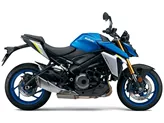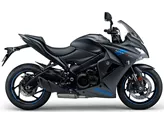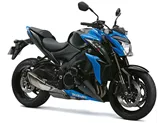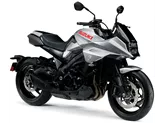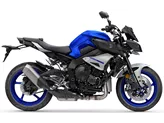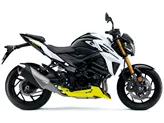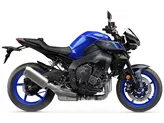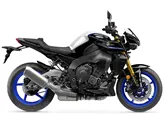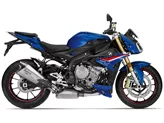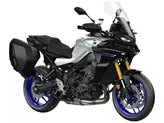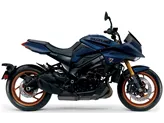Suzuki GSX-S1000 2018 vs. Yamaha MT-10 2016

Suzuki GSX-S1000 2018

Yamaha MT-10 2016
Přehled - Suzuki GSX-S1000 2018 vs Yamaha MT-10 2016
When comparing the Suzuki GSX-S1000 2018 and the Yamaha MT-10 2016, it is clear that both bikes have their own unique strengths and weaknesses.
Starting with the Suzuki GSX-S1000 2018, it boasts a stable handling that inspires confidence, making it a great choice for riders who value control and precision. Its engine power of 149 HP and torque of 106 Nm provide a wonderfully sporty experience, delivering strong acceleration and exhilarating performance. The bike's injection fuel system ensures efficient fuel delivery, while its liquid cooling system helps maintain optimal engine temperature. With a displacement of 999 ccm, the GSX-S1000 offers a good balance between power and efficiency.
In terms of suspension, the GSX-S1000 features an upside-down telescopic fork at the front and a swing arm with a monoshock at the rear, providing a comfortable and smooth ride. The aluminium frame, specifically the twin tube design, offers a lightweight yet sturdy construction, contributing to the bike's overall stability and handling. The double disk brakes with a diameter of 310 mm provide reliable stopping power, and the advanced rider assistance system of ABS ensures added safety during braking maneuvers.

Suzuki GSX-S1000 2018
In terms of dimensions and weights, the GSX-S1000 has a front tire width of 120 mm and a rear tire width of 190 mm, both with a diameter of 17 inches. The wheelbase measures 1460 mm, providing stability and maneuverability. The seat height of 815 mm offers a comfortable riding position for most riders, and the bike has a kerb weight of 209 kg, including ABS. The fuel tank capacity of 17 liters allows for longer rides without frequent refueling.
On the other hand, the Yamaha MT-10 2016 offers some unique strengths of its own. Its engine power of 160 HP and torque of 111 Nm provide a strong character and exhilarating performance. The bike's injection fuel system ensures efficient fuel delivery, while its liquid cooling system helps maintain optimal engine temperature. With a displacement of 998 ccm, the MT-10 delivers impressive power and acceleration.
Similar to the GSX-S1000, the MT-10 features an upside-down telescopic fork at the front and a swing arm with a monoshock at the rear, providing a comfortable and smooth ride. The aluminium frame, specifically the Deltabox design, offers a lightweight yet sturdy construction, contributing to the bike's overall agility and high-speed stability. The double disk brakes with a diameter of 320 mm provide strong and reliable stopping power. In addition to ABS, the MT-10 also features traction control, further enhancing its safety and stability.

Yamaha MT-10 2016
In terms of dimensions and weights, the MT-10 has similar specifications to the GSX-S1000, with a front tire width of 120 mm and a rear tire width of 190 mm, both with a diameter of 17 inches. The wheelbase measures 1400 mm, slightly shorter than the GSX-S1000, but still providing good stability and maneuverability. The seat height of 825 mm may be a bit higher for some riders, and the bike has a kerb weight of 210 kg, including ABS. The fuel tank capacity of 17 liters is the same as the GSX-S1000, allowing for longer rides without frequent refueling.
In terms of weaknesses, the Suzuki GSX-S1000 2018 is reported to be a little jerky when changing from push to load. Some riders also feel that a quickshifter with blipper would greatly enhance the bike's performance. On the other hand, the Yamaha MT-10 2016 is criticized for its poor comfort, limited wind protection, and hard fit.
In conclusion, both the Suzuki GSX-S1000 2018 and the Yamaha MT-10 2016 offer unique strengths and weaknesses. The GSX-S1000 excels in stable handling, sporty engine performance, and overall riding comfort. The MT-10, on the other hand, impresses with its strong character, agility, high-speed stability, and advanced rider assistance systems. Riders should consider their priorities and preferences when choosing between these two naked bikes.
Technické údaje Suzuki GSX-S1000 2018 ve srovnání s Yamaha MT-10 2016
Výhody a nevýhody ve srovnání
Výhody a nevýhody ve srovnání
Suzuki GSX-S1000 2018

Model GSX-S 1000 od Suzuki vypadá sexy, má silný zvuk a opravdu chytrý hardware. Jezdí stabilně, lehce a je s ní zábava jezdit i na výlety. V případě potřeby motor prudce zakouří. Dá se ale také mírně rozjet. Oproti nejlepším Powernakedům mu sice chybí jednotlivé funkce, ale každý, kdo se podívá na cenovku, rychle pochopí: Skvělá volba!
Yamaha MT-10 2016

Krátký a zavalitý MT-10 je z proslulých výkonných naháčů vzhledově i podvozkově nejvzdálenější superbiku R1, ale srdce MT-10 přímo vychází ze závodní zbraně a fascinuje jedinečným syrovým zvukem a výkonem odspodu díky typickému posunu klikového čepu, který s upraveným pořadím střelby zajišťuje tento jedinečný charakter. Výsledných 160 koní se proto jen na papíře jeví ve srovnání s více než 200 koňmi modelu R1 jako poněkud slabých, ve skutečnosti však i MT-10 rozpoutá neuvěřitelný ohňostroj. Odpružení by bylo pro závodní okruh asi příliš měkké, ale pro souboj na venkovské silnici je tak akorát, a stejně tak brzdy - pro okruh asi jen přijatelné, ale na venkovskou silnici ideální.
Srovnání cen průměrná tržní cena Suzuki GSX-S1000 vs Yamaha MT-10
There are a few key differences between a Suzuki GSX-S1000 2018 and a Yamaha MT-10 2016. In terms of price, the actual average price of a Yamaha MT-10 2016 is about 6% higher. A Suzuki GSX-S1000 2018 experiences a loss of 270 USD in one year and 1,010 USD in two years of ownership. This is offset by a loss of 800 USD and 1,840 USD for a Yamaha MT-10 2016. Compared to Yamaha MT-10 2016 there are more Suzuki GSX-S1000 2018 bikes available on the 1000PS.de Marketplace, specifically 9 compared to 7. It takes less time to sell a Yamaha MT-10 with 97 days compared to 177 days for the Suzuki GSX-S1000. Since model year 2015 1000PS.de editors have written 36 reviews for the Suzuki GSX-S1000 and 32 reviews for the Yamaha MT-10 since model year 2016. The first review for the Suzuki GSX-S1000 was published on 9/27/2014 and now has more than 17,100 views. This compares to more than 20,700 views for the first review on Yamaha MT-10 published on 11/17/2015.


